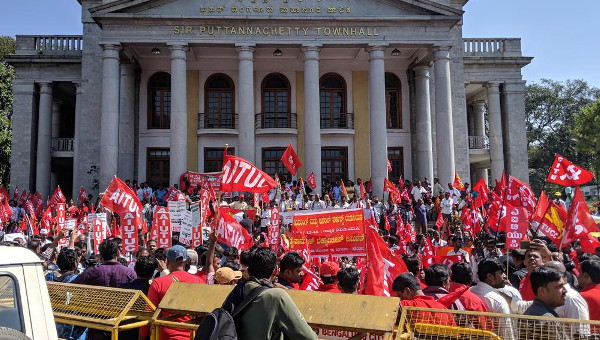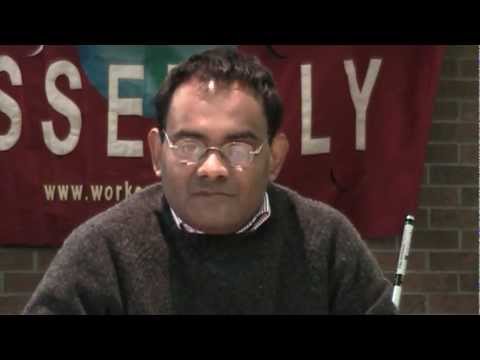Since India embraced what trade unions call the LPG route to growth (that is liberalization, privatization and globalization) in 1991, the country has seen 16 general strikes. And the 17th all India workers’ strike falls on September 2nd. The last general strike, observed on 2 September 2015, saw participation from nearly 150 million workers – that’s half the population of the entire U.S., or more than the combined population of the UK, Canada and Australia. This year, the unions expect a better turnout given the controversial labour policies pursued by the Narendra Modi-led NDA government.
Why are the workers resorting to industrial action? And why have they been doing this so consistently over the past decade or more? In this strike, all central trade unions, except the RSS-backed Bharatiya Mazdoor Sangh (BMS), will join hands with independent national federations of workers in banks, insurance, telecom and state and central government departments to protest what they call the “anti-worker, anti-people policies of the government pushing the lives of the working people at large as well as the national economy to the path of disaster.” So, are these unions striking just for getting their kitty fatter, as alleged by a section of the media and office-bearers of the BJP and some ministers? A closer look at the unions’ charter of demands will give some clues.
Charter of Demands
First off, the unions want the government to take urgent measures to contain price rise by making the public distribution system more efficient and banning speculative trade in the commodity market. Prices of essential commodities – which hits the common man where it hurts – have been soaring in the country for a while now. As economists CP Chandrasekhar and Jayati Ghosh recently noted, the annual consumer inflation began rising in August 2015, and hit a one-year high in July. Which means, the unions are not sleep-talking. Price rise is a real and present danger. The next demand is to generate employment through concrete measures. It is a fact that India has not been able to deliver a meaningful increase in the number of jobs in the past few decades, especially during the 25 years of economic reforms. The National Sample Survey Office data on jobs in 2011 showed that between 2004-05 and 2009-10, only 1 million jobs were added every year, while the economy grew at a record average of 8.43 per cent annually, and, shockingly, 55 million people joined the labour force. Now, nearly 1 million people enter the job market every month.
The unions want strict enforcement of all basic labour laws without any exception or exemption and stringent measures to punish those who violate these rules. This demand gains so much importance at a time when the government itself is seen diluting key labour regulations such as the Factories Act of 1948 and the Shops and Establishments Act, giving more powers to employers and making employees vulnerable to exploitation. In this context, the unions’ demand for universal social security cover for all workers seems all the more important. To be fair, this is not an unusual demand. Workers in many advanced countries such as Canada and Sweden enjoy universal social security benefits.
And that’s why the next demand of the unions – minimum wage of not less than Rs.18,000 [about $350 CDN] a month with provisions of indexation (for unskilled worker) – is critically important. The Minimum Wages Act-1948 says the government should review wages every five years. But that rarely happens. For instance, the farm sector saw its last revision in 2005; sweeping and cleaning was reviewed in 2008, and construction in 2009. India’s informal work sector is staring at a crisis today with hire-and-fire policies making job prospects alarmingly unstable. This is an area where even organized trade unions have not been able to make much inroads into. Even though the NDA government stated a few months ago that it was going to review minimum wages, nothing substantial has come through. The unions’ charter calls for assured, enhanced pension not less than Rs.3,000 a month for the entire working population. This includes unorganized sector workers as well. Hence, the unions want the government to initiate policies to stop contractorization in permanent/perennial work and payment of the same wage and benefits for contract workers as that of regular workers for “the same and similar work.” They also demand removal of all ceilings on payment and eligibility of bonus and provident fund and increase in quantum of gratuity.
Stop Disinvestment and Privatizing
The unions demand the government stop disinvestment in Central and State public sector companies. This year, the government has set the total target for divestment at Rs.56,500 crore. While the government claims that disinvestment can help it improve the structure of incentives and accountability of state-run companies, workers claim that so far the experience has been discouraging. The government is privatizing even profit-making companies, not just the loss-making ones as promised, imperilling millions of workers and even shaking the foundations of the economy in favour of what the unions call “private monopoly capital.” They also demand no foreign direct investment in critical and nationally important sectors such as the Railways, defence and other strategic sectors. But the government does not buy this logic. The official think-tank of the Centre, the Niti Aayog, has already called for privatizing the Railways. And there are already moves to bring in private participation in defence.
And that takes us to the final and most important component in the unions’ demand list – no unilateral amendment to labour laws. The unions allege that most of the critical labour regulations initiated by the NDA in the recent past were taken unilaterally and the government did not consult with any of the trade unions. Of course, the finance minister and labour minister had met with BMS leaders for exclusive discussions, but no other important union was involved in these consultations. So, the unions say it’s a ‘make-or-break’ moment in history for them and industrial action is the only way forward. In sum, how India’s workers respond to September 2nd will be critical to the future of employment in the country. •
This article first published on the Number 13 website.
India: 150 Million Workers on Strike!
View on YouTube website




